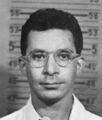Template:Selected anniversaries/May 30: Difference between revisions
No edit summary |
No edit summary |
||
| Line 14: | Line 14: | ||
File:Samuel Bentham.jpg|link=Samuel Bentham (nonfiction)|1813: Engineer, naval architect, and crime-fighter [[Samuel Bentham (nonfiction)|Samuel Bentham]] uses Pantopticon technology to locate and capture alleged supervillain [[Neptune Slaughter]]. | File:Samuel Bentham.jpg|link=Samuel Bentham (nonfiction)|1813: Engineer, naval architect, and crime-fighter [[Samuel Bentham (nonfiction)|Samuel Bentham]] uses Pantopticon technology to locate and capture alleged supervillain [[Neptune Slaughter]]. | ||
||1814: Eugène Charles Catalan born ... mathematician who worked on continued fractions, descriptive geometry, number theory and combinatorics. His notable contributions included discovering a periodic minimal surface in the space {\displaystyle \mathbb {R} ^{3}} \mathbb {R} ^{3}; stating the famous Catalan's conjecture, which was eventually proved in 2002; and, introducing the Catalan numbers to solve a combinatorial problem. | ||1814: Eugène Charles Catalan born ... mathematician who worked on continued fractions, descriptive geometry, number theory and combinatorics. His notable contributions included discovering a periodic minimal surface in the space {\displaystyle \mathbb {R} ^{3}} \mathbb {R} ^{3}; stating the famous Catalan's conjecture, which was eventually proved in 2002; and, introducing the Catalan numbers to solve a combinatorial problem. Pic. | ||
||1846: Peter Carl Fabergé born ... goldsmith and jeweler. Pic. | ||1846: Peter Carl Fabergé born ... goldsmith and jeweler. Pic. | ||
| Line 29: | Line 29: | ||
||1909: Norris Edwin Bradbury born ... physicist who served as Director of the Los Alamos National Laboratory for 25 years from 1945 to 1970. He succeeded Robert Oppenheimer, who personally chose Bradbury for the position of director after working closely with him on the Manhattan Project during World War II. Bradbury was in charge of the final assembly of "the Gadget", detonated in July 1945 for the Trinity test. Pic. | ||1909: Norris Edwin Bradbury born ... physicist who served as Director of the Los Alamos National Laboratory for 25 years from 1945 to 1970. He succeeded Robert Oppenheimer, who personally chose Bradbury for the position of director after working closely with him on the Manhattan Project during World War II. Bradbury was in charge of the final assembly of "the Gadget", detonated in July 1945 for the Trinity test. Pic. | ||
||1912: Wilbur Wright dies ... inventor. Pic. | |||
||1912: Julius Axelrod born ... biochemist and academic, Nobel Prize laureate. Pic. | ||1912: Julius Axelrod born ... biochemist and academic, Nobel Prize laureate. Pic. | ||
Revision as of 09:31, 15 April 2019
1423: Mathematician and astronomer Georg von Peuerbach (nonfiction) born. He will be remembered for his streamlined presentation of Ptolemaic astronomy in the Theoricae Novae Planetarum.
1813: Engineer, naval architect, and crime-fighter Samuel Bentham uses Pantopticon technology to locate and capture alleged supervillain Neptune Slaughter.
1946: Physicist Louis Slotin dies. He was fatally irradiated in a criticality incident during an experiment with the demon core at Los Alamos National Laboratory.
1964: Physicist and academic Leo Szilard dies. He conceived the nuclear chain reaction in 1933, and patented the idea of a nuclear reactor with Enrico Fermi.
1967: US Army research team uses Gnomon algorithm techniques to convert modern plowshares into ancient swords. In response, APTO field agents confiscate the weapons and revoke Army access to all Gnomon algorithm source files.
1971: NASA launches the Mariner 9 spacecraft. It will map 70% of the surface of Mars, and study temporal changes in the atmosphere and surface.
2016: Blue Green Spiral voted Picture of the Day by the citizens of New Minneapolis, Canada.
2017: Dennis Paulson of Mars celebrates the forty-sixth anniversary of the launch of Mariner 9.







